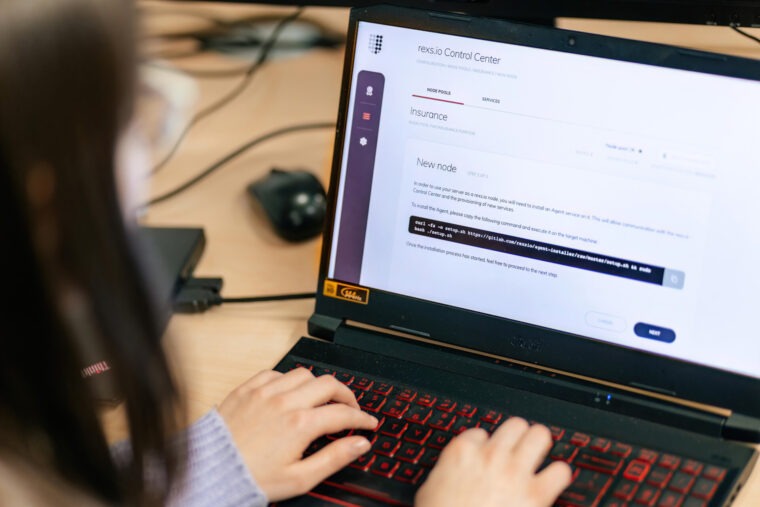
Blockchain.
A link to tamperproof security and validation solutions.

Blockchain is one of the technologies that will become increasingly helpful in the coming years. The beginnings of blockchain reach as far back as the 1990s when this technology was introduced by researcher scientists Stuart Haber and W. Scott Stornetta. However, it gained popularity and momentum in 2008 with the introduction of Bitcoin.
What exactly is blockchain?

As defined by IBM, blockchain is a shared, immutable ledger that facilitates recording transactions and tracking assets in a decentralized network. These transactions can include tangible (a house, a car, money, or a piece of land) or intangible (intellectual property, branding, copyrights, or patents) assets. Anything of value can be tracked and traded on a blockchain.
The significance of Ethereum
Today, blockchain technology has matured significantly with use cases across different sectors (e.g., finance, digital art and collectibles, information security). But even though we owe it to Bitcoin for giving it wide publicity, one of the most significant milestones in the evolution of blockchain technology was 2013, when Ethereum concepts were drawn and later introduced.
Ethereum is an open-source, public service that facilitates blockchain to propel smart contracts and cryptocurrency trading securely without a third party. It introduced programmable smart contracts that triggered the overall growth of blockchain technology. Think of Ethereum as a global computer capable of running and executing any program or business logic.
Smart contracts are self-executing agreements with contract terms directly encoded into lines of code. They automatically enforce and execute actions based on predefined conditions, eliminating the need for intermediaries. The underlying blockchain technology provides a secure, tamper-proof, and transparent way to conduct transactions and agreements. Smart contracts enable decentralized applications and processes across various industries and sectors.
Blockchain & Smart Contracts 101

The workings of blockchain technology, blockchain network, and distributed ledger technology
A user or application initiates a transaction by creating a request to perform a specific action on the Ethereum network. This action could be sending Ether (the native cryptocurrency of Ethereum) or interacting with a smart contract.
The request is then formed into a transaction. This transaction contains essential information, including the recipient address (for sending Ether or a smart contract), the amount of Ether to send (if applicable), and any additional data required for the smart contract to execute a specific function.
The transaction is signed using the sender’s private key, ensuring that only the rightful owner can authorize and submit the transaction.
The signed transaction is broadcasted to the Ethereum network, typically through a node or a wallet provider. At this point, the transaction is in a “pending” state, waiting to be included in a block.
Miners on the Ethereum network collect pending transactions and group them into a block. They compete to solve a cryptographic puzzle, with the first successful miner adding the block to the blockchain. This confirms the transactions within the block, including the one initiated earlier.
Once the block is added to the blockchain, the transaction is considered confirmed. The recipient receives the transferred Ether, or, in the case of a smart contract interaction, the intended function is executed.
The details of the completed transaction, including the transaction hash, block number, and gas used, are recorded on the blockchain. Anyone can view this information to verify the transaction’s success and details.
Blockchain networks

Public blockchains are decentralized and open networks accessible to anyone. They are distributed ledgers that record transactions and smart contract interactions across a vast network of computers globally. Public blockchains, like Ethereum and Bitcoin, rely on a consensus mechanism, such as Proof of Work or Proof of Stake, to validate and secure transactions, with the former being heavily criticized for being very energy-consuming.
They offer high transparency, security, and immutability, making them ideal for applications that require a trustless environment and where data integrity is paramount. However, they may have limitations in terms of scalability and privacy due to their open nature.
Private blockchains, on the other hand, are restricted, permissioned networks that operate within a defined group or organization. Access to the blockchain and its functionalities is limited to approved participants, usually controlled by an entity or consortium.These blockchains provide a more centralized approach, allowing for increased control, scalability, and higher transaction speeds than public blockchains.
Private blockchains are often used in enterprise settings, enabling businesses to streamline operations, collaborate securely, and control sensitive data and processes. However, they sacrifice some degree of decentralization and complete transparency in public blockchains.
Blockchain and distributed
ledger technology (DLT)
Blockchain and DLT are frequently considered synonyms. However, it’s not entirely accurate.
Distributed Ledger Technology (DLT) is a broader concept encompassing various technologies and protocols beyond blockchain. DLT is a decentralized database shared across multiple participants or nodes, each having a copy of the entire ledger. Unlike traditional centralized databases, DLT does not have a central authority or a single point of control. It allows for peer-to-peer communication, consensus mechanisms, and secure data storage and sharing.
Blockchain is a specific type of DLT. It is a decentralized and distributed digital ledger that records transactions across a network of computers securely and transparently. Blockchain utilizes cryptographic techniques to ensure data integrity, immutability, and consensus mechanisms to validate transactions. It operates on a blockchain, each containing a set of transactions. Beyond Blockchain, other types of DLTs include Directed Acyclic Graphs (DAGs) or Hashgraphs.
DLTs can be used across various industries and business verticals that operate on data and include multiple parties with often conflicting interests.

Blockchain technology across different business sectors
We are currently experiencing a constant evolution of use cases and the technology behind DLT. Its applications grow across businesses. Here is a cross-section of scenarios where blockchain can make a noticeable difference.

Supply Chain Management
Utilizing distributed ledgers in supply chain management allows for real-time tracking and traceability of products from their origin to the end consumer. This helps verify product authenticity, quality, and compliance, reducing counterfeits and ensuring transparency.

Financial Transactions and Settlements
Distributed ledgers can streamline financial transactions, especially cross-border payments and settlements, by reducing processing times and costs. The immutable and transparent nature of the ledger enhances trust and security in financial transactions.

Legal Agreements
Implementing smart contracts on a distributed ledger automates and enforces contract terms, reducing the need for intermediaries and ensuring transparency and fairness in agreements. It is particularly beneficial in legal, real estate, and business contracts.

Identity Management and Verification
Leveraging distributed ledgers for identity management ensures secure and tamper-proof storage of personal identity data. It can streamline identity verification, access control, and KYC (Know Your Customer) compliance.

Healthcare Data Management
Storing healthcare records and patient data on a distributed ledger enhances data security, accessibility, and interoperability among healthcare providers. It ensures accurate and immutable medical records, crucial for patient care.

Intellectual Property and Royalties
Using distributed ledgers for managing intellectual property rights and tracking royalties ensures transparent and fair distribution of revenues among content creators, authors, artists, and inventors.

Voting and Elections
Employing distributed ledgers for voting systems enhance the integrity and security of the electoral process. It can reduce voter fraud, ensure transparency, and provide a tamper-proof record of votes.

Tokenization of Assets
Asset tokenization on distributed ledgers represents ownership or shares of real-world assets like real estate, artwork, or commodities. It allows for fractional ownership, increased liquidity, and easier transfer of assets.

Internet of Things (IoT) Data Integrity
Integrating IoT devices with distributed ledgers ensures the integrity and security of the vast amount of data generated by these devices. It can be helpful in sectors like agriculture, manufacturing, and logistics.

Education and Academic Credentials
Storing academic credentials and certifications on a distributed ledger provides a secure and verifiable way to authenticate educational qualifications, reducing the risk of credential fraud.

Our Blockchain projects
Interesting blockchain figures

From 2022 to 2030, the worldwide blockchain technology industry is predicted to grow at an 87.7% CAGR.

The total cost of incorporating blockchain into healthcare might reach $5.61 billion by 2025.

According to a Deloitte survey, 86% of people believe Blockchain technology can enhance our integration toward more touchless business processes.

86% of tech-savvy teams recognize significant benefits associated with blockchain technology.
Let’s incorporate blockchain into your business operations
As you can see, blockchain can be used across different business sectors. We’re confident we could find a way to improve your business with this versatile technology. Don’t hesitate to contact our experts, and let’s find the best solutions tailored to you.
Schedule a meeting and talk about your project with Krzysztof Gola – General Manager Software at DAC.digital

Estimate your project.




